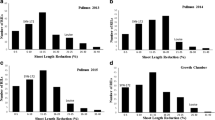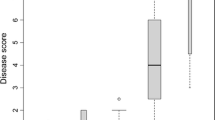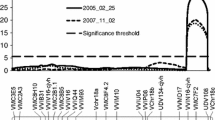Abstract
A survey of DNA polymorphisms and bacterial ring rot reactions inSolanum species was conducted to identify parents that when crossed would produce an F1 mapping population useful for identifying DNA markers tightly linked to genes for immunity or resistance to bacterial ring rot.Solanum tuberosum, S. acaule, diploidSolanum species, doubled monoploid lines ofS. phureja, and somatic fusion hybrids betweenS. tuberosum andS. brevidens were established in tissue culture from single true potato seeds or tubers and evaluated for bacterial ring rot reactions in greenhouse studies with root-inoculated tissue cultured plantlets. Establishment of tissue culture stocks insured the availability of homogeneous genetic material for use in bacterial ring rot assays and genetic analyses. Presence ofClavibacter michiganense subsp.sepedonicum was assessed in stems by an immunofluorescence antibody assay (IFAS). Two accessions were found to be immune to bacterial ring rot. DNA polymorphisms were detected within and among 24 accessions evaluated with 24 RFLP markers and 10 arbitrary oligonucleotide primers (RAPDs). These results identify parents suitable for future mapping of gene (s) for immunity or resistance to bacterial ring rot.
Compendio
Se condujo un estudio de reacciones a los polimorfismos del DNA y a la pudrición bacteriana en anillo en especies de Solanum para identificar progenitores que el ser cruzados puedan producir una población cartográfica F1 útil para identificar marcadores del DNA estrechamente ligados a genes apra inmunidad o resistencia a la pudrición bacteriana en anillo. Solanum tuberosum, S. acaule, especies diploides de Solanum líneas monoploides dobladas de S. phureja e híbridos de fusión somática entre S. tuberosum y S. brevidens fueron colocados en cultivo de tejidos de semillas sexuales individuales o tubérculos y evaluados para reacciones a la pudrición bacteriana en anillo en estudios de invernadero con plantitas de cultivo de tejidos inoculadas en la raíz. El establecimiento de reservas de cultivo de tejidos aseguró la disponibilidad de material genético homogéneo a ser utilizado en pruebas con la pudrición bacteriana en anillo y en análisis genéticos. Se déterminó la presencia de Clavibacter michiganense subsp. sepedonicum en los tallos por la prueba de inmunofluorescencia de los anticuerpos (IFAS). Se encontraron dos entradas inmunes a la pudrición bacteriana en anillo. Se detectaron polimorfismos del DNA dentro y entre las 24 entradas evaluadas con 24 marcadores RFLP y 10 imprimadores de oligonucleotide arbitrarios (RAPDs). Estos resultados identifican progenitores apropiados para futura cartografía de genes para inmunidad o resistencia a la pudrición bacteriana en anillo.
Similar content being viewed by others
Literature Cited
Austin, S., M. Baer and J.P. Helgeson. 1985. Transfer of resistance to potato leaf roll virus fromSolanum brevidens intoSolanum tuberosum by somatic fusions. Plant Sci. 39: 75–82.
Austin, S., E. Lojkowska, M.K. Ehlenfeldt, A. Kelman and J.P. Helgeson. 1988. Fertile in terspecific somatic hybrids of Solanum: A novel source of resistance toErwinia soft rot. Phytopathology 78: 1216–1220.
Barone, A., E. Ritter, U. Schachtschabel, T. Debener, F. Salamini, F. and C. Gebhardt. 1990. Localization by restriction fragment length polymorphism mapping in potato of a major dominant gene conferring resistance to the potato cyst nematodeGlobodera rostochiensis. Mol Gen Genet 224: 177–182.
Bernatzky, R. and S.D. Tanksley. 1986. Methods for detection of single or low copy se quences in tomato on Southern blots. Plant Mol Biol Rep 4: 37–41.
Bishop, A.L. and S.A. Slack. 1987. Effect of cultivar, inoculum dose, and strain ofClavibacter michiganense subsp.sepedonicum on symptom development in potatoes. Phytopathology 77: 1085–1089.
Bonierbale, M.W., R.L. Plaisted and S.D. Tanksley. 1988. RFLP maps based on a common set of clones reveal modes of chromosomal evolution in potato and tomato. Genetics 120: 1095–1103.
Bonierbale, M.W., M.W. Ganal and S.D. Tanksley. 1990. Applications of restriction fragment length polymorphisms and genetic mapping in potato breeding and molecular genetics.In: The Molecular and Cellular Biology of the Potato. Vayda, M.E., and Park, W.D. (eds). CAB International, Wallingford, UK. pp. 13–24.
Bonierbale, M., R. Plaisted, O. Pineda, and S.D. Tanskley. 1994. QTL analysis of trichomemediated insect resistance in potato. Theor Appl Genet 87: 973.
Davis, M.J., A.G.Jr. Gillespie, A.K. Vidaver and R.W. Harris. 1984.Clavibacter. a new genus containing some phytopathogenic coryneform bacteria, includingClavibacter xyli subsp.xyli sp. nov., subsp. nov. andClavibacter xyli subsp.cynodontis subsp. nov., pathogens that cause ratoon stunting disease of sugarcane and bermuda grass stunting disease. Internat J System Bacteriol 34: 107–117.
Debener, R., F. Salamini and C. Gebhardt. 1990. Phylogeny of wild and cultivatedSolanum species based on nuclear restriction fragment length polymorphisms (RFLPs). Theor Appl Genet 79: 360–368.
De Boer, S.H. and M.E. McNaughton. 1986. Evaluation of immunofluorescence and monoclonal antibodies for detecting latent bacterial ring rot infections. Am Potato J 63: 533–543.
De Boer, S.H. and M. McCann. 1989. Determination of population densities ofCorynebacterium sepedonicum in potato stems during the growing season. Phytopathology 79: 946–951.
De Boer, S.H. and M. McCann. 1990. Detection ofCorynebacterium sepedonicum in Potato cultivars with different propensities to express ring rot symptoms. Am Potato J 67: 685–695.
Demeke, T., L.M. Kawchuk and D.R. Lynch. 1993. Identification of potato cultivars and clonal variants by random amplified polymorphic DNA analysis. Am Potato J 70: 561–570.
Douches, D.S. and K. Ludlam. 1991. Electrophoretic characterization of North American potato cultivars. Am Potato J 68: 767–780.
Feinberg, A.P. and B. Vogelstein. 1983. A technique for radiolabelling DNA restriction fragments to high specific activity. Anal Biochem 132: 6–13.
Fish, N., A. Karp and M.G.K. Jones. 1987. Improved isolation of dihaploidS. tuberosum protoplasts and the production of somatic hybrids between dihaploidS. tuberosum andS. brevidens. In Vitro 23: 575–580.
Gebhardt, C., E. Ritter, T. Debener, U. Schachtschabel, B. Walkemeier, H. Uhrig and F. Salamini. 1989. RFLP analysis and linkage mapping in Solanum tuberosum. Theor Appl Genet 78: 65–75.
Gebhardt, C., E. Ritter, A. Barone, T. Debener, B. Walkemeier, U. Schachtschabel, H. Kaufmann, R.D. Thompson, M.W. Bonierbale, M.W. Ganal, S.D. Tanskley and F. Salamini. 1991. RFLP maps of potato and their alignment with the homoeologous tomato genome. Theor Appl Genet 83: 49–57.
Gudmestad, N.C. 1987. Recommendations of the national task force for the eradication of bacterial ring rot. Am Potato J 64: 695–697.
Gudmestad, N.C., D. Baer and C.J. Kurowski. 1991. Validating immunoassay test performance in the detection ofCorynebacterium sepedonicum during the growing season. Phytopathology 81: 475–480.
Hedrick, 1971. A new approach to measuring genetic similarity. Evolution 25: 276–280.
Hinze, K., R.D. Thompson, E. Ritter, F. Salamini and P. Schulze-Lefert. 1991. Restriction fragment length polymorphism-mediated targeting of the ml-o resistance locus in barley (Hordeum vulgare). Proc Nat Acad Sci USA 88: 3691–3695.
Huaman, Z. and R.W. Ross. 1985. Updated listing of potato species names, abbreviations and taxonomic status. Am Potato J 62: 629–641.
Kriel, C., S. Jansky, N. Gudmestad and D Ronis. 1993a. Screening for bacterial ring rot immunity in wildSolanum species. Am Potato J 70: 823 (Abstract).
Kriel, C., N. Gudmestad, D. Ronis and S. Jansky. 1993b. Inheritance of bacterial ring rot immunity inSolanum acaule. Am Potato J 70: 822 (Abstract).
Kurowski, C.J. and F.E. Manzer. 1992. Reevaluation ofSolanum species accessions showing resistance to bacterial ring rot. Am Potato J 69: 289–298.
Lubbers, E.L., K.S. Gill, T.S. Cox and B.S. Gill. 1991. Variation of molecular markers among geographically diverse accessions ofTriticum tauschii. Genome 34: 354–361.
Manzer, F.E. and C.J. Kurowski. 1992. Bacterial ring rot disease development in resistant and susceptible cultivars. Am Potato J 69: 363–370.
Manzer, F.E., N.C. Gudmestad and G.A. Nelson. 1987. Factors affecting infection, disease development and symptom expression of bacterial ring rot. Am Potato J 64: 671–675.
McMullen, M.D. and R. Louie. 1989. The linkage of molecular markers to a gene controlling the symptom response in maize to maize dwarf mosaic virus. Mol Plant Microbe Interact 2: 309–314.
Messeguer, R., M.W. Ganal, M.C. de Vincente, N.D. Young, H. Bolkan and S.D. Tanksley. 1991. High resolution RFLP map around the root-knot nematode resistance gene (Mi) in tomato. Theor Appl Genet 82: 529–536.
Nelson, G.A. and G.C. Kozub. 1983. Effect of total light energy on symptoms and growth of ring rot-infected red pontiac potato plants. Am Potato J 60: 461–468.
Nkongolo, K.K., N.L.V. Lapitan, J.S. Quick and M.D. Muhlmann. 1993. An optimized fluorescencein situ hybridization procedure for detecting rye chromosomes in wheat. Genome 36: 701–705.
Paterson, A.H., S. Damon, J.D. Hewitt, D. Zamir, H.D. Rabinowitch, H.D., S.E. Lincoln, E.S. Lander and S.D. Tanksley. 1991. Mendelian factors underlying quantitative traits in tomato: comparison across species, generations, and environments. Genetics 127: 181–197.
Quiros, C.F., A. Ceada, A. Georgescu and J. Hu. 1993. Use of RAPD markers in potato genetics: segregations in diploid and tetraploid families. Am Potato J 70: 35–42.
Ritter, E.T. Debener, A. Barone, F. Salamini and C. Gebhardt. 1991. RFLP mapping in potato chromosomes of two genes controlling extreme resistance to potato virus X (PVX). Mol Gen Genet 227: 81–85.
Segal, G., M. Sarfatti, M.A. Schaffer, N. Ovi, D. Zamir and R. Fluhr. 1992. Correlation of genetic and physical structure in the region surrounding the I2 Fusarium oxysporum resistance locus in tomato. Mol Gen Genet 231: 173–185.
Slack, S.A., A. Westra and A. Loniello. 1988. Bioassay ofCorynebacterium sepedonicum using potato plantlets. Am Potato J 65: 501 (Abstract).
Slack, S. A. 1987. Biology and ecology ofCorynebacterium sepedonicum. Am Potato J 64: 665–701.
Slack, S.A. and C. Gedye. 1988. Screening for bacterial ring rot resistance in the interregional potato (IR-1) germplasm collection. Final research report submitted to the Plant Introduction Station, Sturgeon Bay, WI. 35 pp.
Tai, T. and S.D. Tanksley. 1990. A rapid and inexpensive method for isolation of total DNA from dehydrated plant tissue. Plant Molec Biol Rep 8: 297–303.
Tanksley, S.D., M.W. Ganal, V.P. Prince, M.C. De Vicente, M.W. Bonierbale, P. Braun, T.M. Fulton, J.J. Giovannani, L. Miller, A.H. Paterson, O. Pineda, M.S. Rider, R.A. Wing, W. Wu and N.D. Young. 1992. High density molecular linkage maps of the tomato and potato genomes. Genetic 132: 1141–1160.
Williams, J.G.K., A.R. Kubelik, K.J. Livak, J.A. Rafalski, and S.V. Tingey. 1990. DNA polymorphisms amplified by arbitrary primers are useful as genetic markers. Nucl Acids Res 18: 6531–6535.
Young, N.D., D. Zamir, M.W. Ganal and S.D. Tanksley. 1988. Use of isogenic lines and simultaneous probing to identify DNA markers tightly linked to the Tm-2a gene in tomato. Genetics 120: 579–585.
Yu, Z.H., D.J. Mackill, J.M. Bonman and S.D. Tanksley. 1991. Tagging genes for blast resistance in rice via linkage to RFLP markers. Theor Appl Genet 81: 471–476.
Author information
Authors and Affiliations
Rights and permissions
About this article
Cite this article
Ishimaru, C.A., Lapitan, N.L.V., VanBuren, A. et al. Identification of parents suitable for molecular mapping of immunity and resistance genes in solanum species. American Potato Journal 71, 517–533 (1994). https://doi.org/10.1007/BF02851324
Accepted:
Issue Date:
DOI: https://doi.org/10.1007/BF02851324




